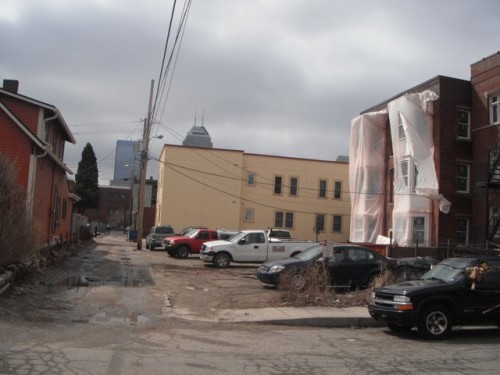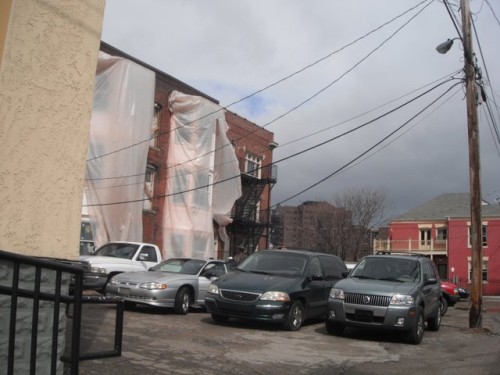One of our Urban Indy bloggers recently pointed out this lovingly restored double with Victorian touches, easily visible on Google Streetview as recently as the last camera run-through, waaaaay back in the summer of 2009. Even from the Google photo, it’s obvious that the restoration just took place; the paint is flawless, landscaping efforts haven’t yet begun, and a “for sale†sign stands in the tiny front garden. This address—105 and 111 9th Street—should be a solid investment: just a stone’s throw from the Indianapolis Public Library, only a twenty minute walk to the heart of downtown, and a quick jaunt from both the nightlife of Mass Ave and the Canal Walk.
But alas—it wasn’t meant to be. Here’s that same home in a photo just a few weeks ago:
Gone forever. Used, for the time being at least, as a parking lot to serve the adjacent three-story apartment buildings. The demolition of an old, recently-restored house is cause for distress even under the best of circumstances; it’s all the worse when it happens (as in this case) in the St. Joseph neighborhood, a Local Preservation District as designated by the Indianapolis Historic Preservation Commission.
The popular local blog Historic Indianapolis noted that the National Register of Historic Places recognized St. Joseph as a historic district in the 1990s. But National Register historic district placement doesn’t provide any legal protection outright, though it allows local governments to leverage this designation as a means of strengthening building codes, particularly as they pertain to the ability to alter or demolish properties within the district that get designated as “contributing†to its historic designation. The smaller home immediately to the east of the demolished home appears intact, though untethered from its neighborhood context, surrounded as it is—in true post-modern fashion—by vast expanses of off-street parking.
So what happened to the charming duplex on 9th? I decided to investigate if my fears had come to fruition: that the owner of the apartment to the west simply bought the structure then demolished it, in order to provide off-street parking for the tenants, willfully disregarding the home’s vintage. It wasn’t hard to find info on the management company.
But my efforts to reach the managers of the Cathcart Apartments were unsuccessful; no returned calls after multiple attempts. My next outlet, the Indianapolis Historic Preservation Commission (IHPC), yielded an almost immediate response. After I briefly described the 9th Street property, the staff member at the Commission remembered the structure and disclosed that, unfortunately, the home suffered significantly in a fire, just weeks before the loving restoration was 100% complete. According to this staff member, the fire took place in March of 2010, a few months after the Google Streetview photo. And the conflagration devastated the building beyond recovery.
Perhaps my muckraking instincts got the best of me, but I couldn’t help but wonder if the circumstances surrounding the fire were suspicious. After all, it wouldn’t be the first time in recent years that a historic structure has burned: the signature “Wedding Cake House†(also in St. Joseph) suffered a suspicious fire a few years ago. Could this have been an example of landowners divesting themselves of an inconvenient but protected property the old-fashioned way, in order to make their property more sellable as a parking lot for the Cathcart Apartments?
Fortunately, it doesn’t appear that anything so insidious took place. The staff member at IHPC revealed that the owner, Bill Connor of Connor and Company construction services, has a solid reputation of buying and renovating older structures in historic districts throughout Center Township. A conversation with Mr. Connor revealed an unexpected story. The home, originally dating from about 1903, belonged to the Cathcart family for decades before it shifted in both ownership and tenancy. Prior to his renovation, the home claimed another floor and housed two units on each side—a four-unit dwelling. The image taken from the 2009 Google Streetview actually portrays the house in the final stages of recovery from another fire: an electrical one, according to Connor. He worked with local preservationists to determine a solution that would comply with St. Joseph’s character, since the habitable attic third floor was unsalvageable after the first fire. Because Connor had every intention of selling the house, an outside instigator evidently caused the fire—either a squatter, a malicious vandal, or someone who jerry-rigged the interior utilities for unlawful use. The fire was also severe enough to spread to the adjacent buildings, further abrogating any good conspiracy theory of a conveniently timed demolition.  After all, flames licked the cottage to the east as well.
The aforementioned damage could explain the tarp on part of the apartments, where a restoration crew is obviously still working.
While the photo above effectively reveals how vehicles are using the former site of 105/111 9th Street, it isn’t as clear which building they are serving. A different angle reveals a critical distinction.
It’s two buildings. The one on the right is Cathcart, while the one on the left (with the bay windows) is The Lodge, currently undergoing a significant renovation, both in response to fire damage and because it seriously needed upgrades.
Leah Orr, a historic researcher and long-term property owner in St. Joseph, had much to say about the Lodge Apartments. Both she and Connor recognized that until recently, the owner was an egregiously absentee landlord. Orr spent years in the courts in an effort to get the woman to improve her building, but she never did; thus, it routinely attracted tenants who took advantage of the negligence to conduct criminal operations. While no one knows the cause of the fire that decimated 105/111 9th Street, it would surprise no one in St. Joseph if residents at the Lodge had something to do with it. Orr and Connor welcome the new developers, who are not only highly sensitive to the building’s historic features, but they are bringing the Lodge up to market-level desirability. In due time, it should be another attractive rental property in an already desirable neighborhood.
For those Urban Indy readers expecting some juicy back-story behind a destroyed building in a historic district, I no doubt have left you deeply disappointed. (Then again, if you’re coming to Urban Indy for lurid sensationalism, your needs are well outside my skill set.) So, what does the future hold for the former site of 105/111 West 9th Street? Connor has acknowledged that he has a Letter of Agreement to the current owner of The Lodge, granting him the first opportunity to purchase the land when he completes the restorations. Most of us, no doubt (and including Connor), share the same suspicion: the site of this house will remain off-street parking for the foreseeable future, isolating the neighboring house in a sea of parking and vitiating the block’s credibility as contributing to the historic character of St. Joseph.
Too bad. But the site of this former home is not so easy to market in an automobile-dominated city. Connor stated that it was only 37.5 by 37.5 feet—barely big enough to fit the garage or even a simple off-street space that most Indianapolis residents expect. The lack of off-street parking holds the site hostage as an independent development, but it could serve as a tasty amenity for the owner of the Lodge: four spaces to serve his future tenants. Orr, meanwhile, is less cynical that the small size of the parcel is so constricting; she acknowledges that many homes in other parts of St. Joseph, Chatham Arch and Lockerbie Square lack garages or spaces for off-street parking. Nonetheless, the homes command high prices and the owners park their cars in the street. She asserts that the St. Joseph Neighborhood Association will actively oppose any efforts to revert the property to a permanent parking lot; it should again become a private residence, either single- or multifamily.
The future of 111/105 East 9th Street remains murky for the time being, but clearly much more is at stake than if it lay outside St. Joseph. Historic district designations seek more than just to protect the physical structures that occupy the land within those boundaries. That, to be honest, is the easy part. Far more challenging is the retention of that character elicited through the district—a wiggle-word that I have abused in this essay as well. What is “characterâ€? It could easily be a sort of collectively perceived atmosphere that prompted the designation to begin with, but it is always fully subject to individual interpretation. A savvy landowner in a historic district will weigh the investment value of this designation against the restrictions it imposes. More precisely, a person developing in a historic district will aim for the “sweet spotâ€â€”an elusive place poised between cultural integrity (encapsulated by the collective good of diverse, contiguous property owners’ interest articulated by a historic preservation commission, with widely variable levels of success) and calculable demand for the land as real estate (assessed by determining and attempting to fulfill its highest and best use). If this destroyed home remains a parking lot, it will remain a bit of a black eye to the historic preservation interests, but it might in turn elevate the desirability of the nearby parcel that the lot serves…in this case, the newly renovated Lodge Apartments, which will attract market-rate tenants for the first time in decades. Preservationists will continue to face this dilemma, at least until demand for off-street parking in Indianapolis weakens to the point we prefer a continuous urban street wall—a full block of adjacent houses!—over an easy, cheap place to put our cars.






The attractiveness of the two apartment buildings (as well as the historic house and whatever takes up the vacant lot) would be massively increased if Pennsylvania was changed to a two way street or got a nice road diet and a grass buffer between the sidewalk and street (aka snow holder).
Same goes for the lofts over on Capitol and St. Clair and pretty much any other development along our way too many one ways.
Thanks for your comments. I agree that the Pennsylvania retail node around 9th/St. Clair would benefit greatly if Pennsylvania was turned to a two-way. But, like you (at least I assume), I’m not holding my breath.
The most likely and practical candidates for a two-way conversion are Alabama and New Jersey, whose status as one ways is nonsensical. Next up is College Avenue, for which we’ve already converted a huge portion, so why not the section south of North/Mass Ave? And, of course, if we convert college, why not Central or East, or both? Next would be the Maryland/Washington pairing, since those weren’t even one way streets until around 1990 or so (with the construction of the new Indianapolis Zoo).
I’d say the least likely streets to go back to two-way are Illinois/Capitol and Pennsylvania/Delaware. But hope springs eternal.